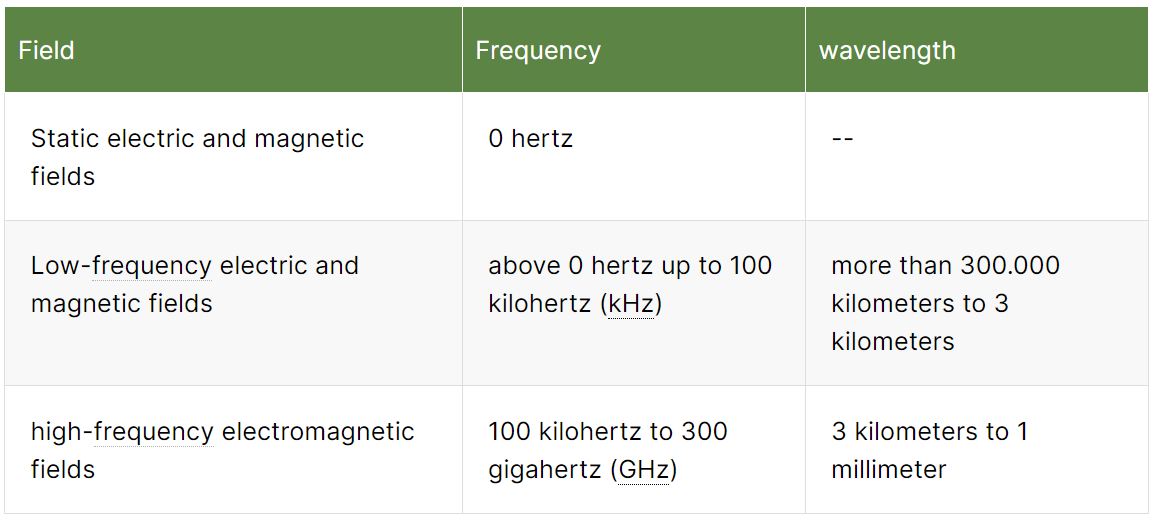-
- Electric and magnetic fields describe the spatial distribution of a force that can act upon electric charges and currents.
- Electromagnetic fields can be generated artificially, but also occur naturally in the environment. They belong to “non-ionizing radiation“.
- With static and low-frequency fields the electric and the magnetic components are considered separately. In the case of high-frequency fields, the two components are closely interrelated and are referred to as electromagnetic fields.
- Low-frequency electric and magnetic fields can produce electric fields and currents in the human body. High-frequency electromagnetic fields can heat up biological tissue.
- It is the task of radiation protection to ensure that the strengths of the fields are so low that no health damage occurs.
Electromagnetic fields are part of the electromagnetic spectrum. Over its entire range, the spectrum extends from static electric and magnetic fields over optical radiation to very energetic gamma radiation. For the part of the spectrum in between static electric and magnetic fields and infrared radiation, the generic term “electromagnetic fields” is common.
When do we speak of fields and of waves or radiation?
Instead of the term “electromagnetic fields”, the expressions “electromagnetic waves” or “electromagnetic radiation” are also used. The various terms describe different physical properties:
How are electromagnetic fields categorized?
In the same way, as the entire electromagnetic spectrum is divided into regions, electromagnetic fields are categorized into different types based on their physical properties. This is done either
-
- according to their frequencies or
- according to their wavelengths.
The unit of measurement for frequency is Hertz (Hz; 1 Hz = 1 oscillation per second). The wavelength is specified in meters (m). Frequency and wavelength are interlinked by the velocity of propagation. At high frequencies, the wavelengths are small, whereas low frequencies are associated with large wavelengths.
Frequencies above 300 gigahertz are generally referred to as “radiation”. The term “field” is not used for this range of the spectrum.
Why do we differentiate between static and low-frequency electric and magnetic fields and high-frequency electromagnetic fields?
With static and low-frequency fields the electric and the magnetic components are considered separately. In the case of high-frequency fields, the two components are closely interrelated and are referred to as electromagnetic fields. As the various ranges of electromagnetic fields have different physical properties, also their effects on biological organisms differ.
Where do we find static, low-frequency, and high-frequency fields?
-
- A naturally occurring static field is the Earth’s magnetic field.
- In the atmosphere, between the Earth and the ionosphere, there is a permanent electric field: the fair weather field.
- Artificial low-frequency electric fields are present around all electrical wires and appliances to which a voltage is applied.
- Low-frequency magnetic fields occur around all electrical appliances and wires with alternating current flowing through them.
- High-frequency electromagnetic fields are used in mobile communications, WLAN, or cordless phones, for example.
What are the effects of electromagnetic fields?
Due to their different physical properties, the various ranges of the electromagnetic spectrum have different effects on biological organisms. In the process, the energy of the individual photons is particularly significant. It increases constantly with increasing frequency.
Electromagnetic fields belong to “non-ionizing radiation“. In contrast to ionizing radiation, the photons of non-ionizing radiation do not have enough energy to ionize atoms and molecules, that is, to “eject” electrons from the shells and to produce positively charged particles (ions) as a result. Among other things, this means that – in contrast to X-radiation – their energy is too low to cause direct damage to genetic material and to be directly involved in the development of cancer.
However, electromagnetic fields can cause health damage in other ways:
It is the task of radiation protection to ensure that the strengths of the fields are so low that no health damage occurs.

